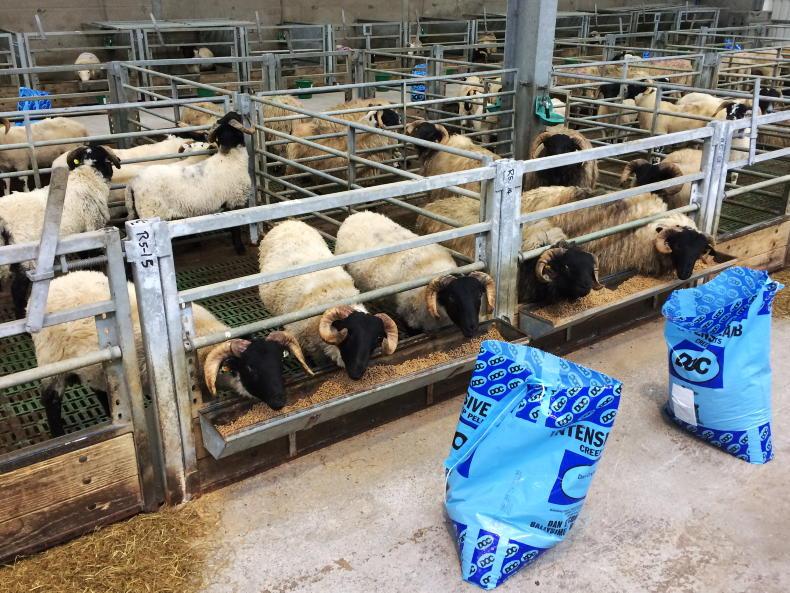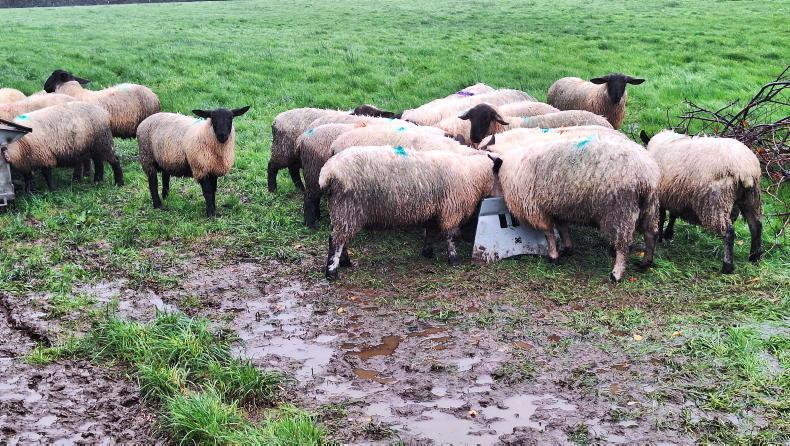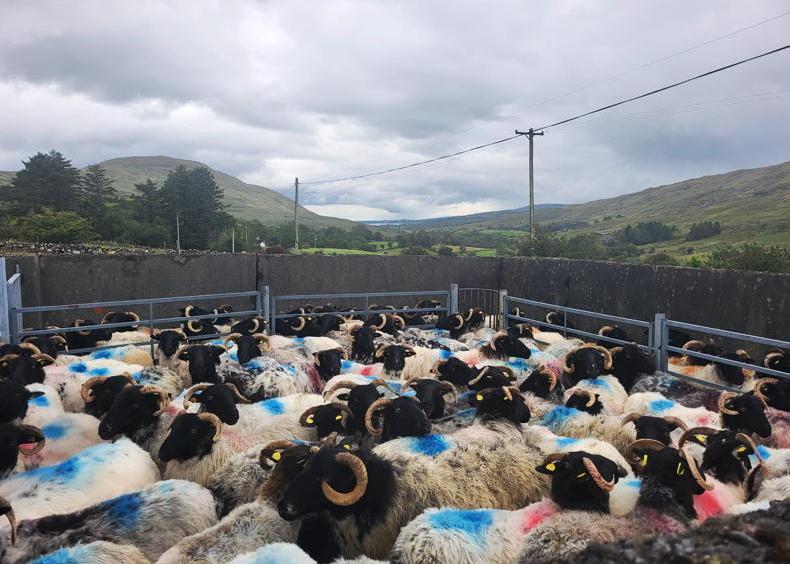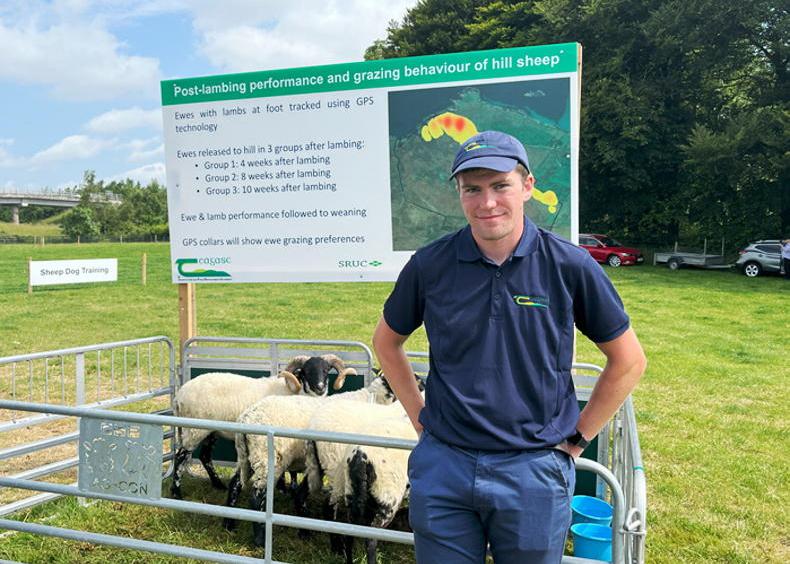The practice of finishing particularly hill-born lambs indoors has been a major focal point of Teagasc sheep research carried out in Mellows Campus Athenry in recent years.
The ongoing research shows the production system is capable of finishing lambs to the desired specifications and generating a positive margin.
Updated management guidelines released by Teagasc in late 2019 provide excellent advice in this area.
Finishing budget
Teagasc sheep programme head Michael Gottstein advises farmers to do a finishing budget before starting to feed to ensure they are on the right track.
The Teagasc store lamb calculator, which is available here, helps with this.
The user inputs data such as the starting weight and value of lambs, production costs, whether or not a period of grazing is utilised and the forecast farmgate sale price.
The price forecast has a function which shows the average sale price in recent years for the time period in which lambs will be finished.
This gives an indication as to how realistic the forecast sale price is.
Health treatments
A health plan covering homebred and purchased lambs should be developed.
Purchased lambs on arrival to the farm should be housed for 48 hours whether they are being turned out to grass for a grazing period or not.
These lambs should receive a quarantine treatment for worms (Zolvix and moxidectin-based product) and fluke, along with foot bathing and assessing lambs for lameness, with footrot and CODD the ailments to look out for.
Lame lambs should be segregated until recovered, as housing provides an ideal environment for rapid spread. Sheep scab is another high-risk issue.
Plunge-dipping or treating with an appropriate macrocyclic lactone-based injectable are the treatment options. Remember to take withdrawal periods into account.
The guidelines advise that long-stay lambs likely to be present for six weeks or longer may benefit from vaccination against clostridial diseases and pasteurella pneumonia.
If orf is already present in the flock and sheep are purchased in or any purchased animals show signs of infection, then vaccination is advised.
Nutrition
Lambs can perform excellently on all-concentrate diets, with daily liveweight gain especially strong in lambs that have developed a good frame.
Concentrate feeds should possess high-energy ingredients, with cereals such as maize, barley, oats and wheat the primary ingredients.
Pulps and distillers grains, along with soya bean meal, beans and peas, are also high-energy, while feeds such as soya hulls, maize gluten and rapeseed meal are medium energy.
Low-energy feeds include pollard or wheat feed, palm kernel and sunflower. This is not to say they should be excluded, rather their inclusion rate should be limited.
Energy content
The target energy content is at least 0.92 UFL. A protein content of 12% is sufficient for finishing lambs, while growing lambs will benefit from 16% crude protein.
The maximum crude oil level should be 6%, while the maximum recommended level of sugar and starch is 35%.
A minimum crude fibre content of 7% will help prevent digestive upset, while it is also advised to offer lambs a source of roughage.
Fresh water is essential, with lambs consuming on average between four and eight litres daily, depending on the dry matter of the diet and intake.

Cheviot lambs performed better than the three Scottish Blackface breed strains in previous trials.
Troughs should be checked daily for cleanliness and supply.
Lambs should ideally be trained into eating meals before being housed and where starting from a low base, built up to ad-lib by increasing 200g every three days.
Lambs need up to 30cm trough space, with horned breeds in cases requiring more.
Environment
At least 0.5m2 floor space should be allocated for hill lambs weighing 25kg and at least 0.8m2 for lambs weighing 45kg to 50kg.
Take account of lambs growing during the finishing stage and what effect this is likely to have on stocking rate and feeding space as the finishing period progresses.
Lambs should be herded twice daily for any signs of sickness. A small number of hill lambs may refuse to eat or are shy eaters, so without special attention will never perform.
These can usually be identified standing at the back of the pen.
Michael Diskin of Teagasc says trials in Athenry show good success in lambs being let back out to pasture for a period and then rehoused.
Where this is not an option, moving to another pen where there is less competition for feed can help.
In Scottish Blackface and crossbred lambs, horns growing inwards may need to be cut to prevent discomfort and injury where piercing the skin.
Lambs which are housed from the hill often also take time to settle and there can be issues such as horns becoming caught in penning, feed barriers or even slats.
Read more
Cracking the store lamb finishing equation
Potential to finish light hill lambs
Wool regrowth trial at Teagasc Athenry
The practice of finishing particularly hill-born lambs indoors has been a major focal point of Teagasc sheep research carried out in Mellows Campus Athenry in recent years.
The ongoing research shows the production system is capable of finishing lambs to the desired specifications and generating a positive margin.
Updated management guidelines released by Teagasc in late 2019 provide excellent advice in this area.
Finishing budget
Teagasc sheep programme head Michael Gottstein advises farmers to do a finishing budget before starting to feed to ensure they are on the right track.
The Teagasc store lamb calculator, which is available here, helps with this.
The user inputs data such as the starting weight and value of lambs, production costs, whether or not a period of grazing is utilised and the forecast farmgate sale price.
The price forecast has a function which shows the average sale price in recent years for the time period in which lambs will be finished.
This gives an indication as to how realistic the forecast sale price is.
Health treatments
A health plan covering homebred and purchased lambs should be developed.
Purchased lambs on arrival to the farm should be housed for 48 hours whether they are being turned out to grass for a grazing period or not.
These lambs should receive a quarantine treatment for worms (Zolvix and moxidectin-based product) and fluke, along with foot bathing and assessing lambs for lameness, with footrot and CODD the ailments to look out for.
Lame lambs should be segregated until recovered, as housing provides an ideal environment for rapid spread. Sheep scab is another high-risk issue.
Plunge-dipping or treating with an appropriate macrocyclic lactone-based injectable are the treatment options. Remember to take withdrawal periods into account.
The guidelines advise that long-stay lambs likely to be present for six weeks or longer may benefit from vaccination against clostridial diseases and pasteurella pneumonia.
If orf is already present in the flock and sheep are purchased in or any purchased animals show signs of infection, then vaccination is advised.
Nutrition
Lambs can perform excellently on all-concentrate diets, with daily liveweight gain especially strong in lambs that have developed a good frame.
Concentrate feeds should possess high-energy ingredients, with cereals such as maize, barley, oats and wheat the primary ingredients.
Pulps and distillers grains, along with soya bean meal, beans and peas, are also high-energy, while feeds such as soya hulls, maize gluten and rapeseed meal are medium energy.
Low-energy feeds include pollard or wheat feed, palm kernel and sunflower. This is not to say they should be excluded, rather their inclusion rate should be limited.
Energy content
The target energy content is at least 0.92 UFL. A protein content of 12% is sufficient for finishing lambs, while growing lambs will benefit from 16% crude protein.
The maximum crude oil level should be 6%, while the maximum recommended level of sugar and starch is 35%.
A minimum crude fibre content of 7% will help prevent digestive upset, while it is also advised to offer lambs a source of roughage.
Fresh water is essential, with lambs consuming on average between four and eight litres daily, depending on the dry matter of the diet and intake.

Cheviot lambs performed better than the three Scottish Blackface breed strains in previous trials.
Troughs should be checked daily for cleanliness and supply.
Lambs should ideally be trained into eating meals before being housed and where starting from a low base, built up to ad-lib by increasing 200g every three days.
Lambs need up to 30cm trough space, with horned breeds in cases requiring more.
Environment
At least 0.5m2 floor space should be allocated for hill lambs weighing 25kg and at least 0.8m2 for lambs weighing 45kg to 50kg.
Take account of lambs growing during the finishing stage and what effect this is likely to have on stocking rate and feeding space as the finishing period progresses.
Lambs should be herded twice daily for any signs of sickness. A small number of hill lambs may refuse to eat or are shy eaters, so without special attention will never perform.
These can usually be identified standing at the back of the pen.
Michael Diskin of Teagasc says trials in Athenry show good success in lambs being let back out to pasture for a period and then rehoused.
Where this is not an option, moving to another pen where there is less competition for feed can help.
In Scottish Blackface and crossbred lambs, horns growing inwards may need to be cut to prevent discomfort and injury where piercing the skin.
Lambs which are housed from the hill often also take time to settle and there can be issues such as horns becoming caught in penning, feed barriers or even slats.
Read more
Cracking the store lamb finishing equation
Potential to finish light hill lambs
Wool regrowth trial at Teagasc Athenry










SHARING OPTIONS